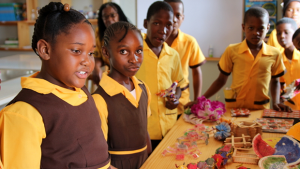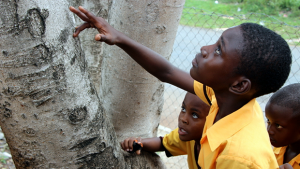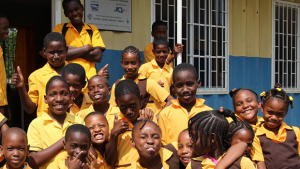
Putting biodiversity education in the fast lane in Jamaica
March 27th, 2015
by Natasha Kate Ward

On a recent visit to a Jamaican School, I was transported back in time to my childhood.
I grew up in a rural area. Our house sat in the middle of a quintessentially English village with gardens and fields, a river, rolling green hills which abruptly turn into limestone cliffs and then tumble into the sea. Given my rural upbringing in a particularly beautiful part of the country, I spent much of my childhood running around outside, wading through rivers, climbing trees, picking flowers and even digging up worms for fishing bait. At primary school we learned our three Rs —reading, writing and arithmetic —like everyone else, but school was so much more exciting when we got to go on field trips outside, learning about local fauna, planting trees, and collecting flowers.
Thirty odd years later and 3,000 miles from Mrs. Ethelston’s Church of England Primary School, I found myself visiting the Chandler’s Pen Primary School in Southern Jamaica. What I saw brought me back to my own school days, and I was delighted to see the school’s strong emphasis on hands-on, nature based learning.
Similar in size to many rural Jamaican schools, Chandler’s Pen has just over 100 students from the surrounding local villages. The children learn English, math, science and history, just as I had many years ago. During my visit, as I peered in the back of the classrooms, which reminded me so much of home, I could sense that overwhelming love of learning. When break-time came round, I was introduced by Vice-Principal Lorna Thomas to a pair of students and best friends, Natalia and Debbian, for a VIP tour of Chandler’s Pen’s new Biodiversity Center.

Natalia is an enthusiastic member of the Chandler’s Pen “Environment Club.” The Club has its own biodiversity curriculum, which focuses on using engaging do it yourself, projects to teach students about a range of biodiversity related issues. Students from grades one through nine take part in hands-on activities like bird watching, tree labeling and recycling, and take field trips to local hot spots for biodiversity. With help from the Institute of Jamaica, the Biodiversity Center is also building up its data library and specimen displays with samples gathered by students.
The origins of the Center are particularly interesting. It was established by a partnership between the Institute of Jamaica and the Natural History Museum of Jamaica, with the support of TransJamaican Highway Ltd. The partnership was established as part of a broader suite of environmental and social measures tied to a local highway project. The IDB teamed up with other international lenders to finance 17km of inter-urban highway in Southern Jamaica. It is standard practice for the IDB (as well as other international financial organizations) to require efforts to mitigate and compensate for any damages or losses to biodiversity that might stem from a project it is financing. Since part of the highway runs alongside a protected area, the parties involved agreed on a novel approach to mitigating future impacts: educating Jamaica’s youth about the importance of biodiversity protection in the interest of the country’s long-term environmental sustainability.

On the day of my visit, Natalia and Debbian took me by the hand and walked me around the Center. They showed me their latest project which involved recycling every day household trash, plastic bottles, newspapers and cans into art work. It didn’t take long before we were surrounded by two dozen more students, all eager to share their projects with me, or show me the latest bug they had found and identified, or tell me about the displays exhibited on the Center’s walls. The excitement was palpable as the students led me out into the school grounds and pointed out their favorite insects, plants and birds. The Environment Club has truly brought a love of all things biodiversity to the children of Chandler’s Pen.
A future goal of the Center is to extend the Programme itself to other schools and local communities in the area. In July 2014, the school hosted a Biodiversity Awareness Resource Workshop, in which 33 teachers from 19 other schools came together alongside special guests to discuss how to expand the Biodiversity Programme throughout the area. The Programme’s leaders also hope that the biodiversity curriculum they have developed will ultimately be adopted into the national curriculum in Jamaica, and one day more broadly throughout the Caribbean.
Natasha is an environmental specialist focused on sustainability, safeguards and corporate social responsibility. At the IDB, she provides support to a wide range of development projects, including agro-industrial, tourism and manufacturing, and previously was involved in the implementation of environmental management systems for financial institutions. She is also the editor of the IDB’s Annual Sustainability Report. Previously Natasha worked for the United Nations Economic Commission of Latin America and the Caribbean, and with the United Kingdom’s Environment Agency regional flood defense team. She holds a B.A. in Modern Languages from the University of Portsmouth, M.A. in Environment, Development and Policy from the University of Sussex, and has qualifications for ISO 14001, OHSAS 18001 and USGBC LEED.
Tags: biodiversity, Caribbean development, education, environment, Jamaica, Natural History Museum of Jamaica, TransJamaican
The Gleaner reserves the right not to publish comments that may be deemed libelous, derogatory or indecent.
To respond to The Gleaner please use the feedback form.
- Three ways the Caribbean can strengthen financing for private companies
- Learning about Jamaica’s Forests by Hiking the Blue Mountains
- Making People Happy
- US Supreme Court: One Less Known Example of How a Supreme Court Decision, Shapes Up Judiciary Reality in the Caribbean
- Crime in Paradise: Preview of Forthcoming IDB Study on Crime in the Caribbean
- Caribbean Diaspora: How Can They Finance Development in the Region?
- Zika Virus and the Economic and Human Reproductive Health Implications for the Caribbean
- Proper Solid Waste Management Involves all of us
- Victimization surveys: 3 common mistakes to avoid
- Social Innovation: The way forward for Civil Society Organizations


